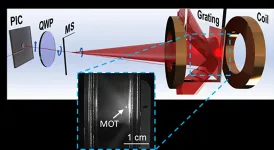(Press-News.org) Food insecurity spiked among residents living in two predominantly African American neighborhoods during the first weeks of the coronavirus pandemic, far outpacing food insecurity observed among the general U.S. population during the same period, according to a new RAND Corporation study.
Following residents of two Pittsburgh low-income African American neighborhoods characterized as food deserts since 2011, the study found that the pandemic increased the number of people facing food insecurity by nearly 80%.
Similar to United States national trends, food insecurity among residents had been improving consistently since 2011. However, the study found that those gains were erased by the pandemic, with the disparities between the predominantly African American residents and U.S. population at the highest levels seen over the past decade.
The findings are published online by the American Journal of Public Health.
"In a short period of time, the coronavirus pandemic has magnified preexisting racial and ethnic disparities in food security," said Tamara Dubowitz, the study's lead author and a senior policy researcher at RAND, a nonprofit research organization. "While food insecurity is linked to a wide variety of health problems, these disparities reflect larger systemic issues including structural racism."
The study involved residents of the Hill and Homewood neighborhoods in Pittsburgh that have been the focus of a long-running research project investigating the influence that diet, access to food and other items have on residents' health and wellbeing.
Both of the neighborhoods are primarily African American and low income. A group of residents of both areas have been surveyed about their access to healthy food on several occasions since 2011.
For the latest study, RAND researchers surveyed a group of 605 residents from the neighborhoods during March, April and May 2020, asking about how the pandemic was affecting their access to food. Researchers have been following the residents since 2011.
The study found that the number of residents reporting food insecurity increased from 20.7% in 2018 to 36.9% in 2020 -- a nearly 80 percent rise. Previous research had shown that food insecurity had been falling in the two neighborhoods since 2011.
Among those surveyed, participation in the Supplemental Nutrition Assistance Program or SNAP (52.2%) and food bank use (35.9%) did not not change significantly during the early weeks of the coronavirus pandemic.
"This finding suggests that existing safety nets may need more support in order to reach those with emerging needs," Dubowitz said. "Lack of reported use could be due to difficulties with SNAP enrollment, problems accessing food banks in the early days of the pandemic or feelings of stigma related to participating in such programs."
INFORMATION:
Support for the study was provided by the National Cancer Institute and RAND, which uses income from RAND's operations and unrestricted philanthropic gifts to support research.
Other authors of the study are Madhumita Ghosh Dastidar, Wendy M. Troxel, Robin Beckman, Alvin Nugroho, Sameer Siddiqi, Jonathan Cantor, Matthew Baird, Andrea S. Richardson, Gerald P. Hunter, Alexandra Mendoza-Graf and Rebecca L. Collins.
The RAND Social and Economic Well-Being division seeks to actively improve the health, and social and economic well-being of populations and communities throughout the world.
When drought caused devastating crop losses in Malawi in 2015-2016, farmers in the southeastern African nation did not initially fear for the worst: the government had purchased insurance for such a calamity. But millions of farmers remained unpaid for months because the insurer's model failed to detect the extent of the losses, and a subsequent model audit moved slowly. Quicker payments would have greatly reduced the shockwaves that rippled across the landlocked country.
While the insurers fixed the issues resulting in that error, the incident remains a cautionary tale about the potential failures of agricultural ...
It's cool to be small. Scientists at the National Institute of Standards and Technology (NIST) have miniaturized the optical components required to cool atoms down to a few thousandths of a degree above absolute zero, the first step in employing them on microchips to drive a new generation of super-accurate atomic clocks, enable navigation without GPS, and simulate quantum systems.
Cooling atoms is equivalent to slowing them down, which makes them a lot easier to study. At room temperature, atoms whiz through the air at nearly the speed of sound, some 343 meters per second. The rapid, randomly moving atoms have only fleeting interactions ...
Black women have higher recurrence and mortality rates than non-Hispanic white women for certain types of breast cancer, according to a University of Illinois Chicago researcher's study published recently in JAMA Oncology.
Dr. Kent Hoskins, associate professor in the UIC College of Medicine's division of hematology/oncology, and co-leader of the Breast Cancer Research group in the University of Illinois Cancer Center, published the study, "Association of race/ethnicity and the 21-gene Recurrence Score with breast cancer-specific mortality among US women" in the Jan. 21 online issue.
Hoskins and the research team sought to discover if breast cancer-specific mortality among women with estrogen ...
Simon Fraser University researchers have found evidence that large ambush-predatory worms--some as long as two metres--roamed the ocean floor near Taiwan over 20 million years ago. The finding, published today in the journal Scientific Reports, is the result of reconstructing an unusual trace fossil that they identified as a burrow of these ancient worms.
According to the study's lead author, SFU Earth Sciences PhD student, Yu-Yen Pan, the trace fossil was found in a rocky area near coastal Taiwan. Trace fossils are part of a research field known as ichnology. "I was fascinated by this monster burrow at first glance," she says. "Compared to other trace fossils which are usually only a few tens of centimetres ...
A new collaborative study from researchers at the Geisel School of Medicine at Dartmouth and the University of Washington (UW) and published in the Proceedings of the National Academy of Sciences (PNAS), reveals unexpected insights into how skin exposure to ultraviolet (UV) light can worsen clinical symptoms in autoimmune diseases such as lupus.
Lupus, an autoimmune disease that can cause inflammation of the joints, skin, kidneys, blood cells, brain, heart and lungs, is caused when the immune system attacks its own tissue.
Previous research has established that in up to 80 percent of lupus patients, sunlight exposure can trigger both local skin inflammation and systemic flares, including kidney disease. But little has been understood about the underlying mechanisms that drive this process. ...
Doctors may be able to predict their patients' risks of fatal coronary heart disease more accurately by taking into account the number of adverse social factors affecting them, according to a new study led by researchers at Weill Cornell Medicine and NewYork-Presbyterian.
The researchers, whose findings appear Dec. 3 in Circulation, analyzed data from the Reasons for Geographic and Racial Differences in Stroke (REGARDS) Study that tracked cardiovascular-related health outcomes in more than 20,000 people for a decade. The new analysis showed that participants who had more adverse social determinants ...
The SARS-CoV-2 virus may enter and replicate in human cells by exploiting newly-identified sequences within cell receptors, according to work from two teams of scientists. The findings from both groups paint a more complete portrait of the various cellular processes that SARS-CoV-2 targets to not only enter cells, but to then multiply and spread. The results also hint that the sequences could potentially serve as targets for new therapies for patients with COVID-19, although validation in cells and animal models is needed. Scientists know that SARS-CoV-2 binds the ACE2 receptor on the surface of human cells, after which it enters the cell through a process known as endocytosis. Research has suggested that the virus may hijack or interfere with other processes such as cellular housekeeping ...
Chimeric Antigen Receptor T-cell therapy--CAR T--has revolutionized leukemia treatment. Unfortunately, the therapy has not been effective for treating solid tumors including childhood cancers such as neuroblastoma. Preclinical studies using certain CAR T against neuroblastoma revealed toxic effects. Now, a group of scientists at Children's Hospital Los Angeles have developed a modified version of CAR T that shows promise in targeting neuroblastoma, spares healthy brain tissue and more effectively kills cancer cells. Their study was published today in END ...
Astronomers at the Center for Astrophysics | Harvard & Smithsonian have detected the first Jupiter-like planet without clouds or haze in its observable atmosphere. The END ...
Friends are more than just trusted confidantes, say Michigan State University researchers who have examined the cultural and health benefits of close human relationships in a new study.
"Friendships are one of the untapped resources people can draw on to pursue a happier and healthier life. They literally cost nothing and have health and well-being benefits," said William Chopik, an assistant professor of psychology at MSU and the study's senior author.
Published in Frontiers of Psychology, the study is the largest of its kind and included 323,200 participants from 99 countries. Prior studies compared only a few specific cultures to one another -- but ...



